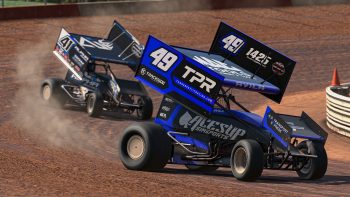
Circle-Track Setup: What Is Toe, And Why Should You Use It?
September 13th, 2013 by Jaime Baker
No matter what kind of motorsport racing there is, there will always be a reason to optimize the contact patch of the tire to gain maximum grip. Since most (!) autosport involves going as fast as possible, in order to do this, the car’s chassis and suspension is going to change attitude, whether it’s a hotlap at Atlanta, F1 at Silverstone, or even a top fuel dragster twisting and bending its rails off the line. Since the chassis is going to change, it will put force on the wheel assembly, and therefore the rubber of the tire, distorting it from its original circular shape.
Problem is, this is racing, darn it, and that means we need to go faster! Well, common-sense physics will tell you that the faster you go, the more force you’re going to put on something. So in other words, the faster the car around a corner, the more wheel spin, the more distorted the tire! So is this a good thing? Actually, yes. Racing tires are designed to stretch to meet the demands of their design. Dirt racing tires come in hundreds of different sizes and compounds to match what a team expects a race to unfold, and if you’re crafty about it (and the rules allow), you can create your own tread patterns with a razor knife.
However, this is old news. Most sanctioning bodies are already onto this knowledge, so they’ve implemented tire rules to keep costs low and the racing field more competitive. So if the racing demands only the use of one certain tire, then you don’t have to worry about getting beat by another tire, but rather by someone who figured out how to get better performance out of their tires.
In a “one-tire rule” racing series, front-end geometry is more important than “open-tire” series.
You’re not getting beat by better technology, you’re getting beat by a better setup. It’s that simple. Someone else has figured out how to make their tires work better than yours. Chances are, it’s through the turns, where the chassis of the car is changing force and distorting the tire. Back to the garage!
Simply put, there are three different ways, or dimensions, to rotate in the world: (1) front to back, (2) side to side and (3) up and down. Since we’re just rotating a wheel assembly, it’s going to affect how the tire acts upon the track surface.
Basically, caster is the “rocking chair” (if you will) of a wheel assembly. We’ll discuss this later.
In short, camber is the lean of a tire. More on this in future articles.
Simply put, toe is the angle that the front tires point in or out.
Look down at your feet. If your toes point in (pigeon-toed), that is positive toe. Conversely, if your feet point out, that’s negative toe.
Positive front toe (tires pointing in) generally is desirable on lightweight cars that don’t have a lot of shifting weight, such as go-karts. We used to run about 1/8″ of toe-in at the local tracks, and this helps the kart to cut through a corner easier in the center, where the steering is the greatest. Cars that do not have load transfer, such as legends cars, can be run with toe-in to great effect at tight-cornering tracks, such as Martinsville or Langley.
Toe-in is also used on dirt to great effect here in Pennsylvania with sprint car racing. Around the pit area, a trick that is used to swing the rear-end of a powerful sprint car around these flat-banked, tight-cornering, and narrow tracks is a trick called “right-front wedge.” Essentially, the teams toe-in the RF tire a little more to make the rear flick out in the center, allowing the driver more drive off the corner on a wet night or if the fast line is around the inside rail. However, this can also make a car that is inherently difficult to keep on a straight line (because of the huge RR tire) even MORE difficult to keep on the straights. In general, big sweeping tracks: more toe-out; tight-turning corners: a bit more toe-in.
However, toe-in also has some disadvantages. Since toe-in forces the car’s momentum through a slightly narrower front wheelbase, the car can feel more unstable in straight lines. This may not be apparent with a 1/16″ or 1/8″ adjustment, but if you add 1/2″ toe-in, you’ll see what I mean!
Also, as the iRacing tooltips in the garage states, adding TOE should increase stability . . . the compromise is that TOE –IN will produce an increase in scrub. Translation: Toe-in will scrub straightaway speed and develop heat in the front tires faster, which can be a good thing in cold weather, but in a longer race, will cause the RF to warm past optimal temperatures.
Generally, toe-out is useful on heavier cars that have a lot of load transfer under braking and heavy cornering. The weight shift causes the front suspension to travel, and therefore impart a greater force onto the steering linkage, causing an added bit of toe-out. To counter this nose-dive, a bit more toe-in will give the driver an added sensation of control and response through the steering column. It takes a lot of force to stop a car, especially so when they weigh upwards of 3,000 pounds!
So let’s review . . .
Lightweight cars: toe-in is generally more useful for quick steering boxes.
Heavyweight cars: toe-out. They need all the help they can get to control the weight transfer.
Tight-cornering tracks: more toe-in. Will help the car turn better.
Long, sweeping tracks: toe-out is generally better.














































